AFFILIATE MARKETING
19 Customer Testimonial Pages in 2023 and What Makes Them Effective

No matter what type of business you run, there’s nothing more impactful for marketing and sales than glowing customer reviews. Customer testimonial pages can be incredibly impactful in driving conversions, building trust and credibility with potential customers, and also improving customer loyalty.
Customer testimonials can make a huge difference and leave an impression that lasts long after they click away.
Here we’ll explore 19 remarkable customer testimonial pages, so you can draw inspiration on how to craft one that resonates with your target customers.
We’ll also dive into why these pages work so well – as each has its own unique style, benefits, and challenges to consider when creating yours!
What Are Testimonial Pages, and Why Should You Have One?
Customer testimonial pages are an invaluable resource for any business, regardless of size or industry.
Put simply, it’s like having a cheering section full of fans! Positive testimonials allow you to show off your accomplishments and share endorsements from past clients who are proud to have worked with you.
A testimonials page highlights real-life success stories from past clients and those already using and benefiting from your goods or services: this helps to build your company’s reputation in a compounding way.
They’re a great way to show off your business and make potential customers feel confident about dealing with you.
It also serves as solid social proof for those unsure of what path to take when making their decision. Positive testimonials are essential for a successful business website since they give customers additional insight into what it’s like working with you.
In short, it’s an invaluable sales tool – getting those “window shoppers” in the door for good!
Great Examples Of Testimonial Pages
Here are a few great examples you can model your pages after!
1. Senja
Senja understands the importance of testimonials, as well they should – that’s what their product is all about!
Senja is a powerful tool that helps users collect video and text testimonials, manage them in one dashboard, and share the final results with beautiful images.
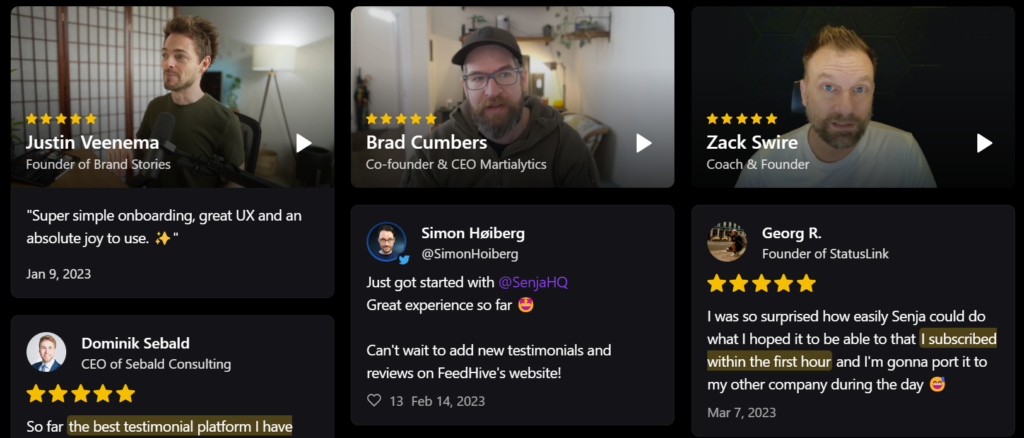
It works across platforms, allowing users to quickly filter tags, ratings, and job titles.
2. Podia

Overflowing with appreciation from its loyal customers, Podia’s testimonials page is a testament to its ability to help entrepreneurs build their presence and succeed online.
Our Podia review and hundreds of others like it have helped show how much users can benefit from the platform.
3. Canny
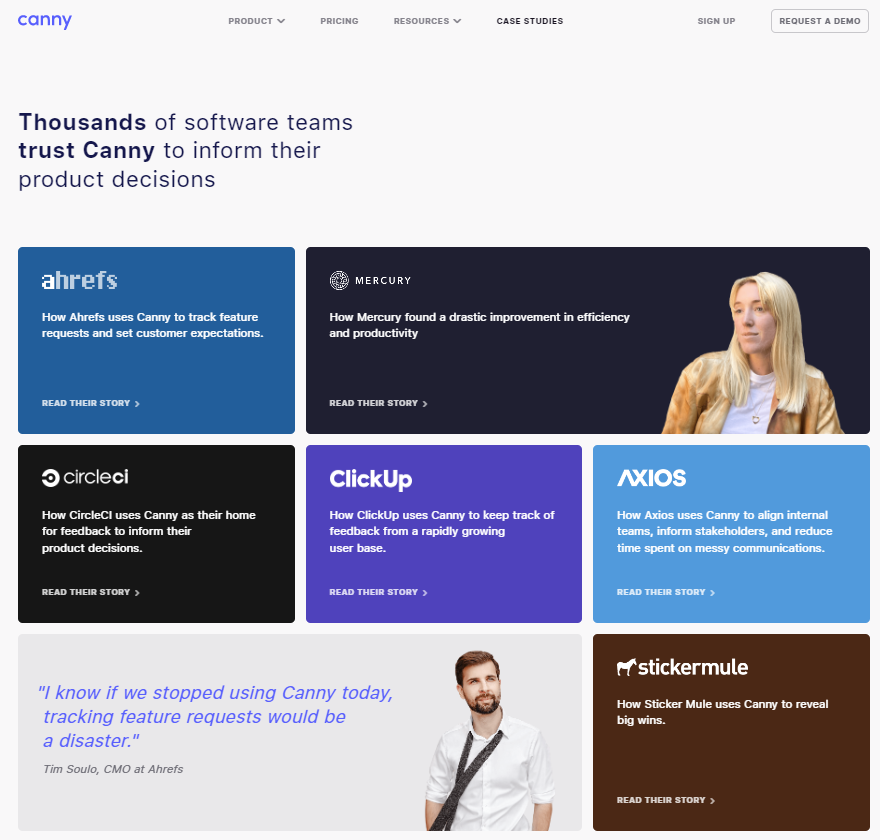
Canny’s testimonials page proves why countless software teams rely on the platform to collect their customer feedback. Through its case studies, you can understand how and why individuals use it to capture customer feedback.
4. Cloudflare
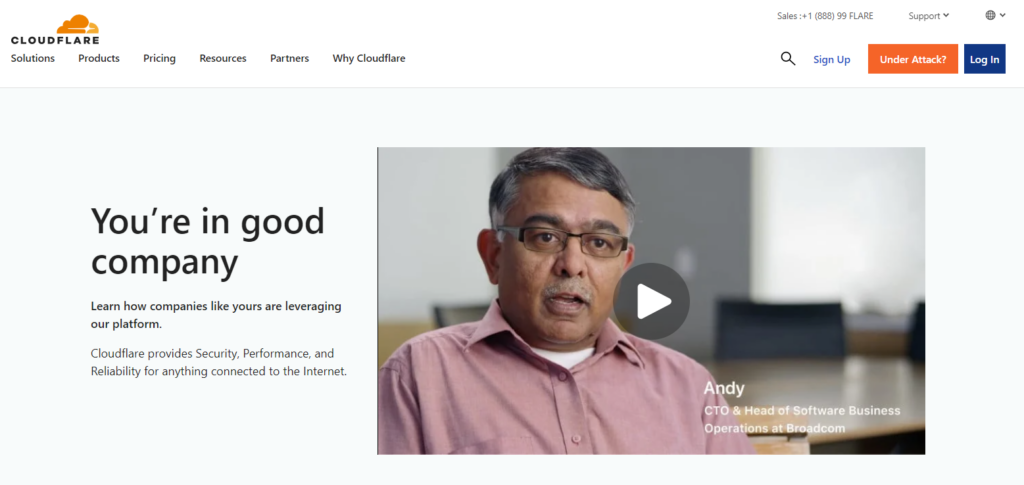
CloudFlare offers various customer reviews in case study format, with long-form articles and videos for visitors to watch. The case studies can be filtered by industry, region, use case, and product/service to make it easier for a potential customer to find relevant testimonials.
5. GetResponse
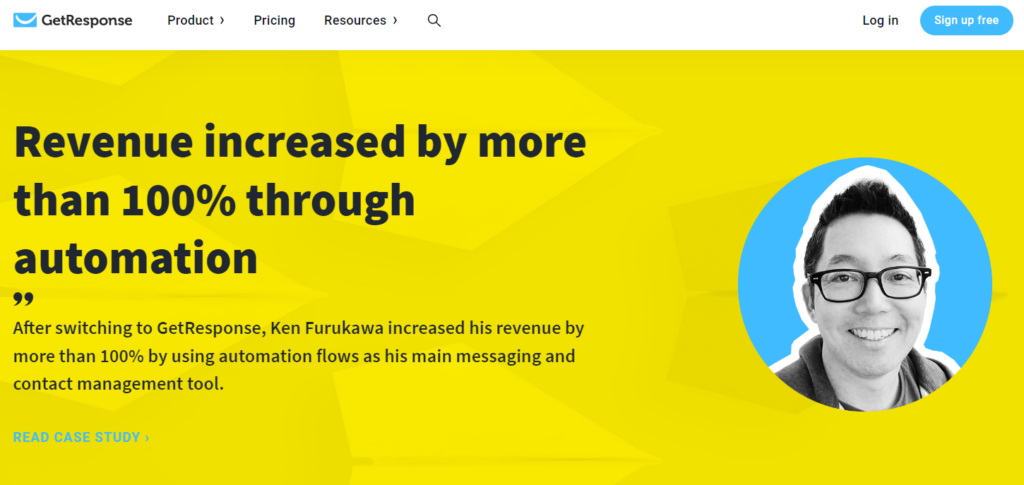
Testimonials should be concise and to the point, yet GetResponse understands that extended blog post testimonials also have their advantages. GetResponse’s website visitors can quickly locate the most relevant recommendations by filtering them based on industry or specific tools used.
6. Shopify
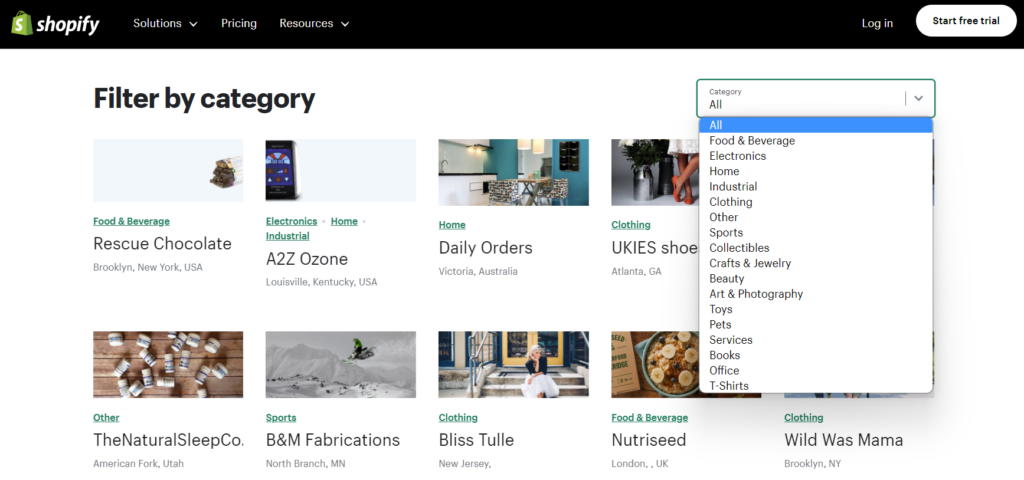
This page is full of inspiring stories from Shopify customers around the world. These success stories highlight how entrepreneurs have used the platform to grow their businesses and what they’ve been able to achieve with it. It’s a great way for a prospective customer to relate on a more personal level and see how successful others using the same tool can be.
7. CodeAcademy

Video testimonials are a great way to add an extra layer of emotion and authenticity to your testimonials. CodeAcademy has taken this approach on its Testimonials page by providing short videos where learners discuss what it felt like to learn coding with the platform.
8. HubSpot Testimonial Pages

Hubspot’s case studies directory allows site visitors to filter by six options to quickly find a pertinent, highly detailed customer success story. Through the HubSpot platform, users can even filter by black-led businesses or female-led businesses to uncover relevant stories of individuals and companies that have achieved success. This makes it easier for readers to identify with the companies showcased on the page.
9. Gong
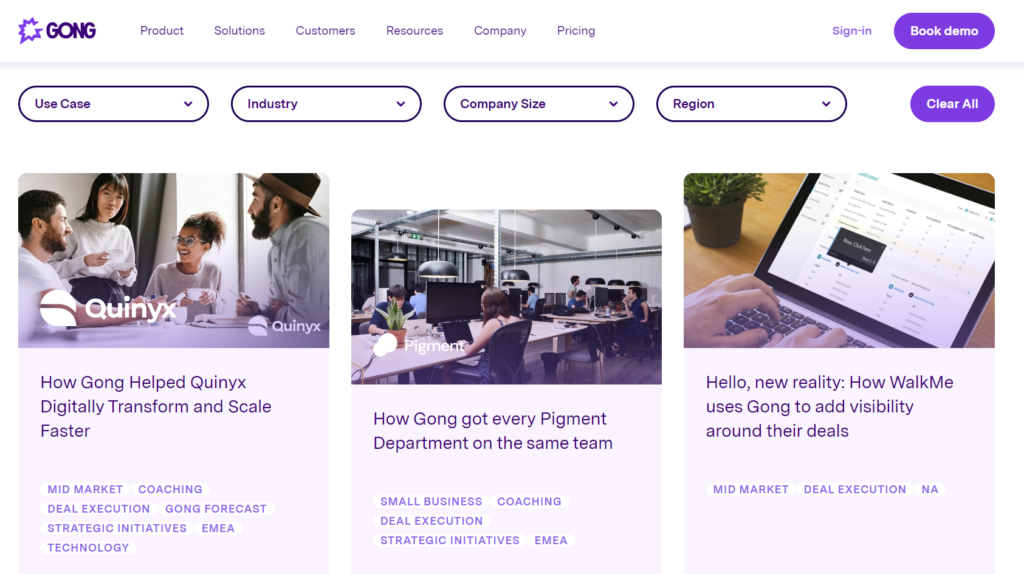
If you’re looking for a great example of how a testimonials page can be done right, then look no further than Gong’s case studies page! Featuring detailed info about how businesses across different industries achieved great results with the platform, it’s a surefire way to get prospective customers excited about using Gong.
10. Leadpages

Leadpages has got testimonials on lock! Their customer page is a smorgasbord of success stories! Users can easily navigate their way through the many categories of case studies, and each category has a bunch of squeaky-clean mini-sagas about how Leadpages are making marketing dreams come true.
11. MultiWebMarketing

At MultiWebMarketing, it’s all about the success stories!
They proudly show off their case studies with amazing images so potential customers can get a real idea of their value if they choose MWM. It’s easy for potential customers to see themselves achieving similar fantastic results!
12. Huemor.rocks
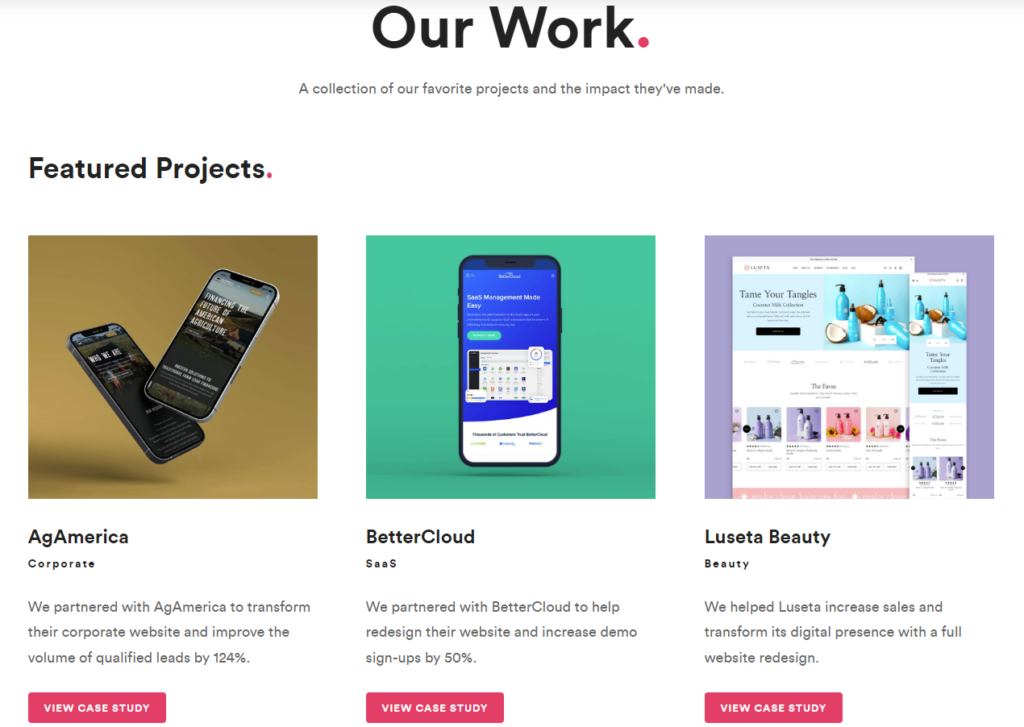
Huemor.rocks knows that great design packs a punch, so they have taken their customer testimonials page to the next level with a stylishly modern and visually impactful page design.
13. Databox Testimonial Pages
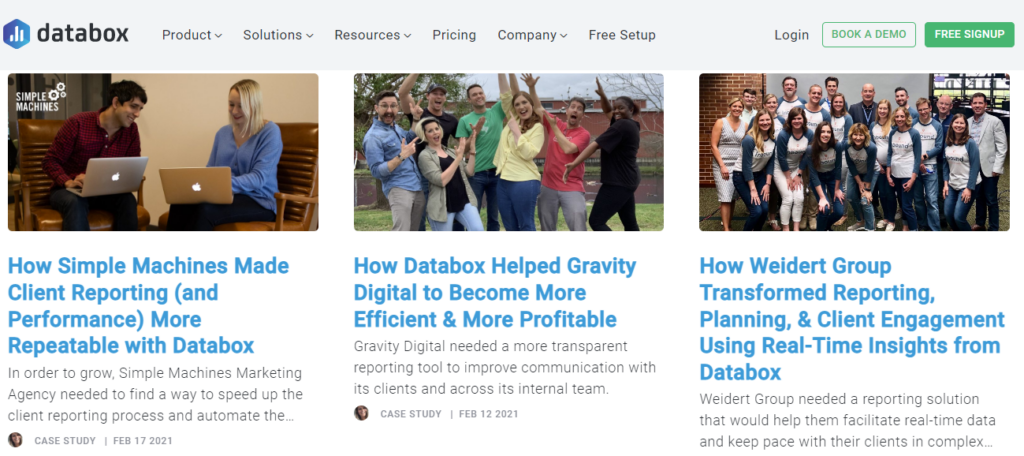
If you’re seeking serious story-time inspiration, look no further than Databox’s testimonials page. It packs a real punch regarding detailed customer stories and data-driven insights.
14. Tray.io

This testimonials page provides insight into how Tray.io’s integration and automation platform can help businesses of all sizes achieve their goals. It showcases the success stories of a variety of customers from different industries, demonstrating the scalability and effectiveness of Tray.io.
15. Heap Testimonial Pages

The Heap Customer Stories page offers a comprehensive selection of customer success stories that show the effectiveness of their platform in helping businesses reach their goals. From increased conversion rates to faster time to insight, these inspiring stories demonstrate the power of Heap’s analytics platform.
16. Zendesk

Zendesk’s testimonials page provides a great insight into the success they’ve achieved with different industries and company sizes.
This allows customers to gain a better understanding of how the service can suit their needs. The page features inspiring customer stories demonstrating how companies have improved their customer service through Zendesk.
17. GoCardless

The GoCardless customer stories page is a great resource to learn how businesses of all sizes are successfully utilizing their payment processing solutions. It’s an inspiring collection of success stories that showcase the power and reach of GoCardless!
18. Applied Systems

The Applied Systems testimonials page showcases the success stories of some of the leading insurance companies in the United States. This makes it a great resource for those looking to understand how to leverage advanced software and solutions for their business.
19. Bonjoro
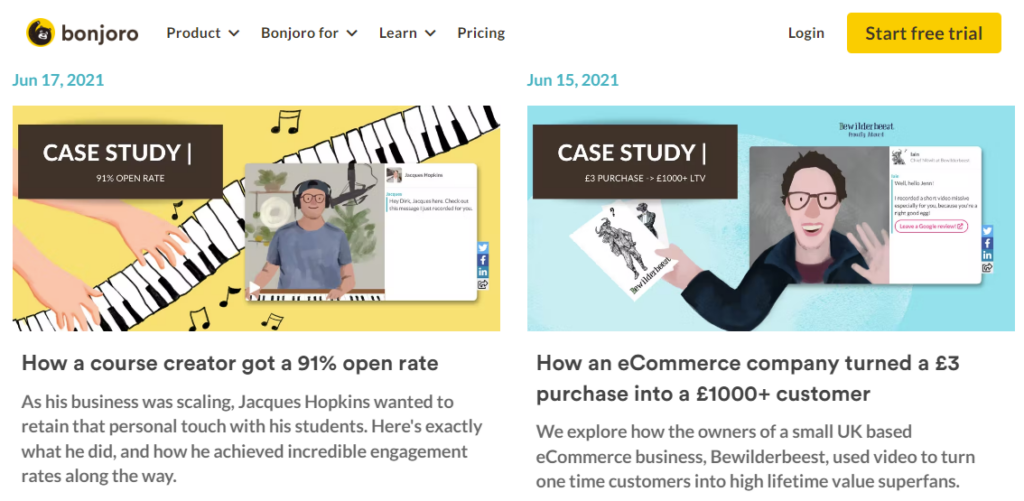
Bonjoro’s testimonials page is an excellent resource for understanding how they have been able to help businesses of all sizes and industries by providing personalized video messages. The vibrant graphics and playful feel make the page engaging and enjoyable, creating a unique user experience that inspires visitors.
How to Create Effective Testimonial Pages
Creating great testimonial pages for your site can be a bit tricky. It requires effort to gather true reviews from honest customers, but the end result is worth the extra work!
While you want to ensure you get rave reviews from satisfied buyers, here are some tips to help you create effective and engaging testimonial pages.
- Authenticity is key when creating an effective testimonials page. Make sure the reviews are genuine and coming from a real person.
- Concise yet detailed reviews are also important, providing more information without rambling.
- Be sure to ask specific questions to get the answers you’re looking for. That way, you can filter out irrelevant information and focus on real people expressing genuine thoughts about your products and services.
- Personalize each review with photos or other visuals to provide powerful visual reinforcement that each review truly comes from an actual customer.
- Keep the conversational tone natural and avoid overly formal language. Nobody wants a scripted-sounding testimonial page!
Different Types of Testimonial Pages
- Video testimonial pages. These are effective because they are often seen as more sincere and authentic than text-only reviews. The best videos feature customers talking about their experiences honestly and genuinely off-script.
- Social media. These are great for showing how real customers interact with your business. They can be a fantastic way to showcase loyalty and trust from your existing customers and reach new visitors.
- Customer interviews. This is a great way to highlight customer stories in an engaging and interactive format. Interviews can provide valuable insight into how customers use your product or service and why they chose you over competitors.
- Long-form testimonials/blog posts. Longer reviews give readers more information about the experience of working with you. They have more detail that can help make decisions.
- Short-form testimonials/quick quotes. These are great for quick and easy reading. They should still include enough detail to showcase satisfied customer experiences effectively.
- Case study/customer success story. These are more in-depth than other types of testimonials. They provide an even more comprehensive understanding of how customers use your products or services.
- Third-party reviews, peer reviews, or authority testimonials. These can increase the authenticity of your testimonial pages since they come from a credible source outside your company.
Regardless of the type of testimonial pages you choose, showcase customers’ genuine experiences with your business.
Tips on How to Get Customer Feedback
- Ask! One of the most effective ways to get customer feedback is simply by asking. You can do this through surveys, emails, or other methods. Make it easy for people by including a link to wherever you want the customer to leave their review.
- Create touch points. Create contact points throughout the customer experience that allow you to capture feedback. You can include surveys on your website, requests for reviews at the end of an order or delivery process, or even provide a link to a short survey in your emails.
- Incentives. Offering incentives like discounts, coupons, or free products are great motivators for customers to leave reviews.
- Follow up on positive experiences. If a customer has had a positive experience with your business, following up and asking them to leave a review can be very effective.
- Social media. Utilizing social media is an easy and effective way to get customer feedback. Posting polls or surveys on your social media pages can help you get responses quickly and easily.
- Analytics and reports. Analyzing your website analytics and customer reports can provide valuable insight into how customers interact with your business. This information can help you identify areas where improvements may be needed and get an idea of how satisfied customers are.
- Customer service and support. Asking customers for feedback on their experience with customer service or support teams is a great way to get honest and insightful feedback. This can help you identify potential areas of improvement.
No matter which method you choose, it’s important to ensure the process is easy and accessible for customers. Provide options for customers to leave feedback in different formats, and be sure to thank them for their time and input.
How to Make Your Testimonial Pages Stand Out from the Competition
- Showcase the most relevant testimonials when displaying testimonials on your website, including ones relevant to the page or product they’re featured on.
- Include customer photos. Including customer photos with the testimonials can help to create a more personal connection with the reader. It also increases the authenticity of the testimonial.
- Keep them up-to-date. Make sure your testimonials are kept up-to-date and regularly refreshed. This way, visitors will have access to the most recent customer experiences.
- Include multiple formats. Offer different formats for customers to leave reviews, including text, video, and audio. This makes it easier for customers with different preferences to leave feedback.
- Make them easy to find. Place customer reviews and testimonials in prominent positions on your website so visitors can easily find and read them.
Testimonial Pages: Final Thoughts
Customer testimonials are a powerful tool for businesses looking to showcase their customers’ experiences.
By following these tips, you can ensure that your testimonials page will effectively build trust and credibility with potential customers.
With the right approach to collecting and displaying customer testimonials, you can create an unbeatable competitive edge.
For more resources to help boost your website’s trust signals and gain credibility, check out these articles next:
The 9 best About Us generators
AFFILIATE MARKETING
How to Know When to Hire Your First Employee

Opinions expressed by Entrepreneur contributors are their own.
At some point as an entrepreneur, you’ll face a challenging decision: When is it time to hire your first employee? After incubating the idea of your startup. then deploying your resources and making it all happen, at some point you may realize it’s time to bring someone else in to help you achieve your vision and grow the business. It’s exciting, but at the same time, can be daunting. What if the new hire doesn’t work out? What if you hire too many people or too few?
Entrepreneurs are inherently self-starters and ambitious, and shifting responsibilities to new workers can be difficult – but it’s a necessary step for growth. A company needs support to grow and thrive. You can’t do it all on your own, which makes hiring employees — especially the early ones — a crucial step toward entrepreneurial success. Before you do anything, though, ask yourself: Is this the right time to hire?
Knowing when you shouldn’t hire
Before addressing best practices for hiring, it’s vital to recognize common pitfalls entrepreneurs face when starting to grow their workforce – that starts with knowing when not to hire. Similar to making big life decisions, you should avoid hiring employees out of anxiety or uncertainty. Your choices should be deliberate and strategic. Take a step back and reconsider hiring employees if you find yourself in the following situations:
You’re desperate
If you have more work than you can humanly handle and you just need to get another body behind a desk, it’s tempting to find someone right away. However, a hasty decision born of desperation is rarely a good one. Take the time to find the right person for the job.
You don’t have specific responsibilities for an employee
Unless you have a defined set of tasks and expectations for your new hire, do them a favor and don’t hire anyone. A new hire at this stage will rightfully be confused and ineffective. You may need help, but if you don’t know exactly what that help will look like, consider hiring a coach instead of an employee.
You’ll take anyone
If you’re lucky, the first applicant will be an absolute rockstar who can bring your business to the next level – but that’s not the norm. You’ll learn a lot about yourself, the applicant market and your own position by interviewing more candidates. The variety of skill sets on display can also hone your focus for what your future employee will do.
Hiring your first employee
Hire someone too early and you could have cash flow problems, a worker who has nothing to do and the added stress of management. Hire too late, and you could be inundated with work you can’t accomplish, which could lead to missing deadlines and losing out on business.
Finding the right moment to hire, therefore, can make the difference between a failed enterprise and a successful business. But how do you know when the time is right? The following tips can make this process a little less painful and provide options for making that first hire:
Start with a cofounder
If you’re a solopreneur looking to make that next step, bringing on an employee can be intimidating. Instead, hire a cofounder, or at least someone who thinks like one.When making that first hire, look for someone with cofounder potential and traits, such as complementary skills, similar values and vision, teachability, passion, emotional intelligence, flexibility and honesty. Your first employee will hopefully be one of your longest lasting and most knowledgeable.
Ask yourself: Will these tasks generate money?
It’s been said that the only two purposes of an employee are to: 1) make money for the business, or 2) save money for the business. If you’re confident a new hire will do at least one of those two things, go for it. In the early stage of a company, making money is more important than saving it. Typically, these early roles involve creating products (designers, developers, etc.), marketing products (growth hackers, content marketers, etc.) and supporting products (customer support, help desk, etc.).
Know your desired skill set
Before you search for an employee, you need to know what kind of candidate you’re looking for. It’s not enough to simply know that you “need some help” or “need a developer.” Get specific: You don’t want just a “developer.” You want a Javascript developer with GitHub experience able to create machine learning algorithms with educational applications, for example. The clearer your set of responsibilities are, the more effectively you can hire someone to fulfill those duties r.
Delay the decision by hiring a contractor
You may still be undecided over whether or not it’s time to hire. Don’t sweat it. Instead, test it. Try hiring a contractor with the same set of parameters you’re looking for in a full-time employee. The introductory hassle of onboarding a contractor is relatively low compared to that of hiring an employee. You can create a contract for one month, six months or a year. If it works out, you can transition this person into an official hire or look for a full-time employee.
The differences between hiring freelancers, contractors and employees
The major differences between freelancers, contractors and employees has to do with their relationship with the business owner. Freelancers and contractors are self-employed individuals, while employees are hired by the company. Freelancers and contractors typically set their schedules based on the needs of their clients and work out a payment schedule (typically upon completion of a job).
Employees, on the other hand, work the schedule established by the company and receive a regular paycheck on a schedule set by the company. As a business owner, you’re responsible for tax reporting on your payroll employees. But since freelancers and independent contractors are considered self-employed, they are responsible for reporting their taxes.
So what’s the best decision for your company? It depends on your needs, your resources and your ambitions.
When should you hire a freelancer?
Some people use the terms “freelancer” and “contractor” interchangeably, but there is a difference in the type of professional you are hiring. Freelancers usually work on smaller, short-term projects, while contractors work on larger, more long-term projects.
Freelancers are great options for specific support — for example, bringing on a digital marketer to get your social media up and running. If you’re not financially ready to bring on full-time employees for whom you have to provide employee benefits, a freelance relationship may be a better setup.
When should you hire a contractor?
Contractors generally come with a team of expert professionals who can get you the help you need, whatever it may be. They can handle specialized projects, such as IT, remodels, design and consulting. As your business grows, financial consultants can keep you on track with your financial goals. If you need highly specialized work that requires a team, contracting a company will ensure the job gets done right.
When should you hire an employee?
Not every company needs a large number of employees, but if you hold frequent meetings, rent an office space or interact with customers, you’ll want reliable employees to help support the business. Remember, just because someone looks good on paper doesn’t mean they’re a good fit for your business. They must fit into your company’s culture. Consider bringing on full-time staff if they can make you more money or improve the customer experience.
Why hiring globally might be your best move
The growing popularity of remote work has meant dramatic growth in the pool of available talent. Don’t limit yourself to just domestic workers, though. By hiring workers outside your country, you can save money, increase efficiency and still provide customers with superior service. Consider the following benefits to hiring globally.
A wider talent pool
As unemployment levels drop, the demand for skilled workers rises — especially for roles in software engineering or data science. By looking past your own borders, you can grow your pool of potential employees and have access to a wider swath of workers. For example, Poland, Slovakia and India are renowned for their pool of highly qualified tech professionals available to work remotely for international companies. Tap into this talent network to find the right fit for your company.
Cost efficiencies
Hiring overseas means access to employees who live somewhere with a much lower cost of living, which generally means lower salary expectations. The requirements for compulsory employer contributions and payroll taxes that increase business costs also vary by country. For example, countries like Germany and Japan generally require that employers deduct a certain amount of the employee’s pay for health insurance. But Australia and New Zealand, with public healthcare systems, do not require such employer insurance contributions.
Access to resilient international markets
If you run a growing, ambitious business, you may be eyeing overseas expansion. One of the biggest factors in your success will be having employees familiar with that market. You have a few options for growing an international presence: set up a local entity or subsidiary (abiding by local employment laws) or use an Employer of Record (EOR) solution, in which you designate a third-party company to handle payroll, HR compliance and employee tax withholding.
Compliance benefits
Employer compliance can vary depending on the country, and some are more strict than others. Whether you’re concerned about at-will employment, parental leave allowance or pension contributions, you can hire from countries whose labor laws align with your needs.
24/7 customer support
Customers expect fast and capable support, no matter where they’re based or when they contact the company. With just 9% of customers able to solve business queries on their own, customer service channels are more important than ever. Having staff in multiple international locations and time zones ensures someone will always answer the support line and provide 24/7 support for your customers.
Before you hire globally, though, you should look into any logistical challenges it might create. Despite the many benefits, hiring international talent can lead to internal communication challenges, scheduling conflicts across time zones, cultural differences, and discrepancies in pay scales. While these challenges can be overcome, they’re worth considering before building a continent-spanning workforce.
Related: 10 Pros (and Cons) of Hiring International Employees
Can college students solve your employee needs?
Different hires provide varying solutions for business, and hiring college students can infuse your company with young energy and ambitious workers. Whether you develop an internship program or employ them part time or seasonally, college students are often more affordable to hire than full-time employees and can support your team’s specific needs.
Creating a pipeline between universities and your business could be a worthwhile investment. Students are trying to get their foot in the door, and they can also provide your company with much-needed help. Here are a few benefits of hiring college students:
They bring fresh perspectives and new ideas
College students are at a unique stage in their lives and are just beginning to form professional identities. Eager to develop skill sets and apply classroom lessons in the professional world, they often bring welcome new perspectives to the table. This can be especially valuable in industries that are constantly changing or in need of innovation.
They’re highly motivated and ready to learn
The most ambitious college students are proactive and eager to take on new challenges — both promising traits for future employees. When you empower college workers, they’ll go above and beyond to learn and contribute to your organization. Additionally, young people are generally tech-savvy and comfortable with digital tools and platforms — a huge asset in today’s business landscape.
They’re cost-effective employees
Because school is the main priority, students are often willing to work for less pay than more experienced candidates; they’re also more open to part-time or internship positions, helping small businesses bring in new talent without breaking the bank. These internships can act as trial runs for potential full-time employment.
How to attract and hire the best salespeople
Just about any business needs persuasive salespeople. In order to sustain and grow your company, you need someone who can bring in new clients while you focus on the business itself. No matter what role someone in your company fulfills, everyone does some kind of selling on a regular basis — pitching investors or bankers, selling coworkers on a new project idea or vision, providing customer service, negotiating with vendors, etc.
Ultimately, though, it will be your sales team that drives your company’s growth. If you want to add top-notch talent to this group and increase your revenue, keep these things in mind:
Your mission should be exciting and purposeful
What are you looking to achieve with your business? Most people these days are looking to join a company because of its mission — its goal to change the world in some meaningful way. According to a 2021 McKinsey study, 70% of Americans say work defines their sense of purpose. Your mission doesn’t need to save lives, it just needs to inspire workers and point to a larger goal. Find salespeople who buy into this mindset, and they’ll evangelize the company or product for you.
Be the best salesperson you can be
If you’re looking to hire salespeople, you should also know how to sell. You may get to a point in your business where you’re not the main person bringing in new clients, but you still have ideas you need to sell to investors, journalists or marketers — and your own team. When interviewing a potential candidate, pay attention to your own energy level. Are you charismatic? Are you enthusiastic about the position and the opportunity? When the interview is done, you’ll want the candidate to feel like they’re ready to jump on your bandwagon and get started right away.
Know what else you can offer
If you can’t compete in the market with a high salary, you can at least offer other incentives that attract top talent and keep your business afloat. Many employees are looking for better work-life balance. Can you offer a flexible work schedule? Consider offering profit sharing or a higher commission in the near future. If your product or services are innovative or revolutionary, that can also be an incentive, as employees are eager to join a business that’s about to rapidly expand.
The best recruiting platforms for small business hiring
When it’s time to hire, finding quality candidates doesn’t need to be complicated. Job search sites can help you recruit and retain talent no matter your company’s budget or size. Some companies advertise jobs across a variety of platforms, and the sites you choose will determine who applies for your open roles.
Similar to reaching a target audience, you want to meet candidates where they already are — think industry-specific forums, alumni networks or on social media. But there’s also value in casting a wide net and posting on major job boards with millions of visitors. With so many platforms to choose from, which will best support your mission? Here are some of the top recruiting platforms to consider:
ZipRecruiter
ZipRecruiter allows you to post job openings and receive applications from relevant candidates, as well as organize applicants in a resume database. Applicant tracking tools, including providing candidates with notes and feedback, also help you manage the hiring process.
LinkedIn is particularly effective for recruiting candidates in the business, finance and technology sectors. To help you find and hire top talent in — and outside of — your network, it offers job postings, resume searches and applicant tracking.
Indeed
One of the world’s largest job search websites, Indeed allows you to search for candidates based on their location, experience and skills. It also provides rates for sponsored listings that prioritize your job openings in the search results.
Glassdoor
In addition to job postings, Glassdoor features reviews from people who’ve worked at various companies. By providing insight into a company’s culture and employee satisfaction, the site can help attract candidates to your open positions.
Workable
With affordable pricing plans and an easy-to-use interface, Workable is a recruiting platform that’s particularly effective for small- and medium-size businesses looking to streamline their hiring process. It offers a variety of features, including job postings, applicant tracking and candidate sourcing.
Writing job advertisements to attract remote workers
The pandemic ushered in a widespread adoption of work-from-home policies that may be here to stay. These policies allow for more flexible working situations, and they’re an excellent way for businesses to stay competitive in the job market.
When writing your job advertisements, keep in mind it’s still just a listing, so you need to effectively communicate the benefits of working remotely and the job requirements. Consider the following tips for writing job advertisements to attract remote workers:
Communicate the remote nature of the job
Specify that the job is a remote position and include details about the type of work environment and equipment that will be required. Does this person need to work certain hours or be in a certain time zone? Spell everything out. If the job advertisement doesn’t say remote up front, many people will assume that it’s not.
Highlight the benefits to employees working remotely
Make it clear that the job offers the flexibility and autonomy of working remotely. Mention any perks or benefits that come with the position, such as a flexible schedule or the ability to work from anywhere.
Clearly outline the job requirements
Your job advertisements should clearly state the skills, experience, and qualifications that are required for the position. This will help you attract the right candidates and weed out those who are not a good fit.
Use language that resonates with remote workers
Use language that speaks to the realities of working remotely. For example, mention the ability to work from anywhere or the need for strong self-motivation and discipline. Also mention skills necessary for collaborating remotely, such as clear and concise communication.
Include information about your company culture
Whether in-person or working remotely, employees place a high value on company culture. In fact, this may be even more crucial in a remote environment, where your only coworker interactions are happening in chats and on video calls. Include information about your company’s values and mission in your job advertisements to help attract candidates who are a good fit.
It’s time to start hiring
By following these tips, you can make the most effective hiring decisions for your business. Keep in mind: no two companies are the same. Before you make a hire — or post a job, for that matter — consider the work you need done, the kind of worker you need to complete it, and where that person should be located. By outlining your needs early, you’ll save money (and headaches) in the long run.
AFFILIATE MARKETING
Franchising Is Not For Everyone. Explore These Lucrative Alternatives to Expand Your Business.

Opinions expressed by Entrepreneur contributors are their own.
Not every business can be franchised, nor should it. As the founder and operator of an exciting, new concept, it’s hard not to envision opening a unit on every corner and becoming the next franchise millionaire. It’s a common dream. At one time, numerous concepts were claiming to be the next “McDonald’s” of their industry.
And while franchising can be the right growth vehicle for someone with an established brand and proven concept that’s ripe for growth, there are other options available for business owners who want to expand their concept into prime locations before their competition does but who don’t want to go it alone for a number of reasons. For instance, they may not have the resources or cash reserves to finance a franchise program (it is important to note that while franchising a business does leverage the time and capital of others to open additional units, establishing a franchise system is certainly not a no-cost endeavor). Or they don’t want the responsibilities and relationship of being a franchisor and would rather concentrate on running their core business, not a franchise system.
Related: The Pros and Cons of Franchising Your Business
But when you have eager customers asking to open a branded location just like yours in their neighborhood, it’s hard to resist. You might think: What if I don’t jump on the deal, and I miss out on an opportunity that might not come around again?
Licensing your intellectual property, such as your name, trademarks and trade dress, in exchange for a set fee or percentage of sales is one way to accomplish this without having to go the somewhat more laborious and legally controlled franchise route. Types of licensing agreements range from granting a license to allow another entity to manufacture or make your products to allowing someone to use your logo and name for their own business. Unlike in a franchise, your partner in a licensing situation will only be allowed certain predetermined rights to sell your products and services, not an all-in agreement to give them a turnkey business, accompanied by training and support, in exchange for set fees. A licensing agreement spells out each party’s rights, responsibilities, and what they can and cannot do under the terms of the agreement. Having a lawyer draw up the paperwork is vital, as well as consulting with a trusted business advisor who has helped others along this path and can shorten your learning curve while protecting your rights. License agreements are governed by contract law as opposed to franchise laws. However, care must be taken: To ensure that you’re staying in your lane and not crossing over into franchisor territory, you’ll want your advisers to detail what you can and can’t do as a licensor.
For instance, a license agreement excludes you from being involved in the day-to-day operations of the licensee’s business. While having no oversight may sound like a relief, it can be a double-edged sword, especially for people who are used to controlling all aspects of their products or services. You won’t have to provide licensees with ongoing services, such as marketing materials and continuous training, but it also means you have no control over how they run their business, their product mix or even how they decorate their space. If you’re a type-A, this may be hard for you.
Most people are more familiar with trademark licensing with a third party because these agreements are big in the sports and entertainment industries, where a celebrity lends their name to endorse a product, whether it’s branded athletic wear or trendy foodservice menu items such as pizza, chicken, or even gelato.
Using a celebrity’s cache garners media attention you might otherwise never get. But not everyone who comes up with a great concept or product has the recognition that would allow them to attract famous business partners or endorsements, and rabid fans that follow.
There are other methods of getting your products in front of more consumers. Some coffee concepts, including Caribou for example, have created market saturation by both franchising traditional stores and granting licenses for nontraditional locations, such as airports, big-box stores, and college campuses. Others, on the other hand, like Starbucks, employ a combination of company-owned stores and licensees in high-traffic locations where a small kiosk can service a high-density population of shoppers. And, of course, bags and pods of these brands’ coffee blends are also sold in retail locations such as grocery stores.
Related: Startups Must Protect Their Trademark. Here’s How and Why
But again, here’s that cautionary note: If you go the licensing route for your products or services, be careful not to cross over into trying to direct the way that licensees do their business, from selecting locations to training employees.
While licensing or franchising may be valid business growth vehicles for many brands, additional business structures that can be considered include:
- Company-owned stores: Opening corporate locations using bank loans and/or the profits from already opened units.
- Dealerships or distributorships: In a distributor relationship, products are purchased from a manufacturer and then sold through local dealers.
- Agency relationships: These are similar to the relationships you’d have with dealers, but in this case, an agent or representative of your company sells your services to a third party. The important distinction to remember so that the relationship doesn’t cross over into franchise territory is that you, as the provider of the services, pay the agent (as an independent sales rep) rather than the agent collecting the money and paying you.
- Joint ventures: In this case, you, as the concept owner, would take on an operating partner who also invests his own funds in the business. The two of you would then share in the equity and profits at the percentage rate of your investment.
The appropriate method to grow your business depends on several factors, including your type of concept, service, or products; your risk aversion factor; your access to capital; where you’re located; and current market conditions. So, if you choose another option to franchising, be cognizant of not slipping into becoming a franchise. The Federal Trade Commission’s regulations define a franchise as meeting at least three standards: a shared name, fees and royalty payments paid to the company by the franchisee, and ongoing support and control of the day-to-day operations by the franchisor.
Keep in mind that if you start with one expansion method, you can consider changing that structure with legal and professional guidance should your business needs merit a shift in strategy. Case in point: some licensors will eventually convert licensees to franchises under a newly crafted agreement and program if they see the need to change the fee structure and maintain additional control over operations.
Slow growth can be detrimental to a business, but not picking the right vehicle for that growth can be worse than standing still. That’s why doing your homework — consulting with professionals, such as attorneys, accounting and franchising advisors, and talking to others in the same boat as you will save you from drifting too far from shore.
AFFILIATE MARKETING
How to Control the Way People Think About You
Opinions expressed by Entrepreneur contributors are their own.
In today’s digital age, where personal branding and public perception play a vital role in success, strategic PR efforts have become more important than ever. Ulyses Osuna, the founder of Influencer Press, joined our show to share valuable insights on the significance of PR, the evolving landscape, and the keys to achieving business growth while maintaining a fulfilling personal life.
One of the key takeaways from the conversation was the importance of strategic PR efforts in building a personal brand and shaping public perception. Ulyses emphasized that PR is not just about getting media coverage; it’s about controlling the narrative and shaping how others perceive you. By strategically positioning yourself and your brand through effective PR, you can influence public opinion and establish yourself as an authority in your field. Another crucial aspect discussed was the power of leveraging relationships and connections.
Ulyses highlighted the “Buglight Concept,” which involves utilizing the support and connections of others to achieve success. By building strong relationships and leveraging the networks of influential individuals, you can significantly expand your reach and influence. Ulyses’s own success with Influencer Press is a testament to the power of connections in the PR world. While professional success is undoubtedly important, Ulyses also stressed the significance of balancing personal time and fulfillment. In the pursuit of business growth, it’s easy to neglect personal well-being and relationships. However, Ulyses emphasized that true success lies in finding a balance between professional achievements and personal happiness.
By prioritizing personal time and fulfillment, entrepreneurs can sustain long-term growth and avoid burnout. In the ever-evolving landscape of PR, Ulyses highlighted the need for a clear mission when seeking press coverage. He emphasized the importance of aligning your brand with a cause or purpose that resonates with your target audience. By having a clear mission and purpose, you can attract media attention that aligns with your values and goals, ultimately enhancing your brand’s reputation and reach. Additionally, Ulyses discussed the importance of pricing services correctly and finding the right balance between personal involvement and business scalability.
The conversation also touched upon the dynamics of client relationships and the impact of showcasing external support. Ulyses emphasized the value of building strong relationships with clients and going above and beyond to exceed their expectations. Furthermore, he highlighted the importance of showcasing external support, such as media coverage or endorsements, to establish credibility and attract new clients. Ulyses’s own podcast, The Blacklist, where he shares insights and interviews successful entrepreneurs, was also discussed. He explained that launching the podcast was a way to give back to the entrepreneurial community and share valuable knowledge.
By continuously learning from others and implementing breakthrough ideas, Ulyses emphasized the importance of immediate action and continuous improvement for business growth. In conclusion, strategic PR efforts are essential for building a strong personal brand and controlling the narrative in today’s digital age. By leveraging relationships, finding a balance between personal and professional life, and having a clear mission, entrepreneurs can shape public perception, expand their reach, and achieve long-term success. Ulyses Osuna’s insights serve as a valuable guide for those looking to navigate the ever-changing landscape of PR and personal branding.
About The Jeff Fenster Show
Serial entrepreneur Jeff Fenster embarks on an extraordinary journey every week, delving into the stories of exceptional individuals who have defied the norms and blazed their own trails to achieve extraordinary success.
Subscribe to The Jeff Fenster Show: Entrepreneur | Apple | Spotify | Google | Pandora
-
SEARCHENGINES6 days ago
Daily Search Forum Recap: April 19, 2024
-

 WORDPRESS7 days ago
WORDPRESS7 days agoHow to Make $5000 of Passive Income Every Month in WordPress
-

 WORDPRESS6 days ago
WORDPRESS6 days ago13 Best HubSpot Alternatives for 2024 (Free + Paid)
-

 MARKETING6 days ago
MARKETING6 days agoBattling for Attention in the 2024 Election Year Media Frenzy
-

 WORDPRESS6 days ago
WORDPRESS6 days ago7 Best WooCommerce Points and Rewards Plugins (Free & Paid)
-

 MARKETING5 days ago
MARKETING5 days agoAdvertising in local markets: A playbook for success
-

 SEO6 days ago
SEO6 days agoGoogle Answers Whether Having Two Sites Affects Rankings
-

 SEARCHENGINES5 days ago
SEARCHENGINES5 days agoGoogle Core Update Flux, AdSense Ad Intent, California Link Tax & More















